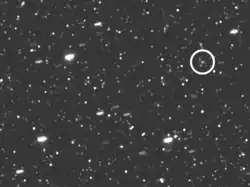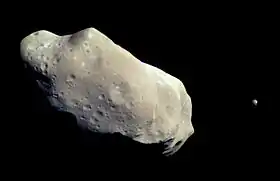Hati (moon)
Hati /ˈhɑːti/ or Saturn XLIII is a natural satellite of Saturn. Its discovery was announced by Scott S. Sheppard, David C. Jewitt, Jan Kleyna, and Brian G. Marsden on 4 May 2005, from observations taken between 12 December 2004 and 11 March 2005.
 Hati imaged by the Cassini spacecraft in November 2015 | |
| Discovery | |
|---|---|
| Discovery date | 2004 |
| Designations | |
Designation | Saturn XLIII |
| S/2004 S 14 | |
| Orbital characteristics [1] | |
| 19856000 km | |
| Eccentricity | 0.372 |
| −1038.7 days | |
| Inclination | 165.8° |
| Satellite of | Saturn |
| Group | Norse group |
| Physical characteristics | |
Mean diameter | 5+50% −30% km[2] |
| 5.45±0.04 h[2] | |
| 24.4 | |
Hati is about 6 kilometers in diameter, and orbits Saturn at an average distance of 20,303 Mm in 1080 days, at an inclination of 163° to the ecliptic (165° to Saturn's equator), in a retrograde direction and with an eccentricity of 0.291. In March 2013, the synodic rotational period was measured by Cassini to about 5.45±0.04 hours. This is the fastest known rotation of all of Saturn's moons.[2]
It was named in April 2007 after Hati, a giant wolf from Norse mythology, son of Fenrisúlfr and twin brother of Sköll.
References
- S.S. Sheppard (2019), Moons of Saturn, Carnegie Science, on line
- Denk, T.; Mottola, S. (2019). Cassini Observations of Saturn's Irregular Moons (PDF). 50th Lunar and Planetary Science Conference. Lunar and Planetary Institute.
- Scott Sheppard's Giant Planet Satellites Page (Saturn Satellite Data)
- Dave Jewitt: 12 new Satellites of Saturn May 3, 2005
- IAUC 8523: New Satellites of Saturn May 4, 2005 (discovery)
- MPEC 2005-J13: Twelve New Satellites of Saturn May 3, 2005 (discovery and ephemeris)
- IAUC 8826: Satellites of Jupiter and Saturn April 5, 2007 (naming the moon)
- Denk, T., Mottola, S. (2013): Irregular Saturnian Moon Lightcurves from Cassini-ISS Observations: Update. Abstract 406.08, DPS conference 2013, Denver (Colorado), October 10, 2013 (synodic rotation period)
.jpg.webp)

